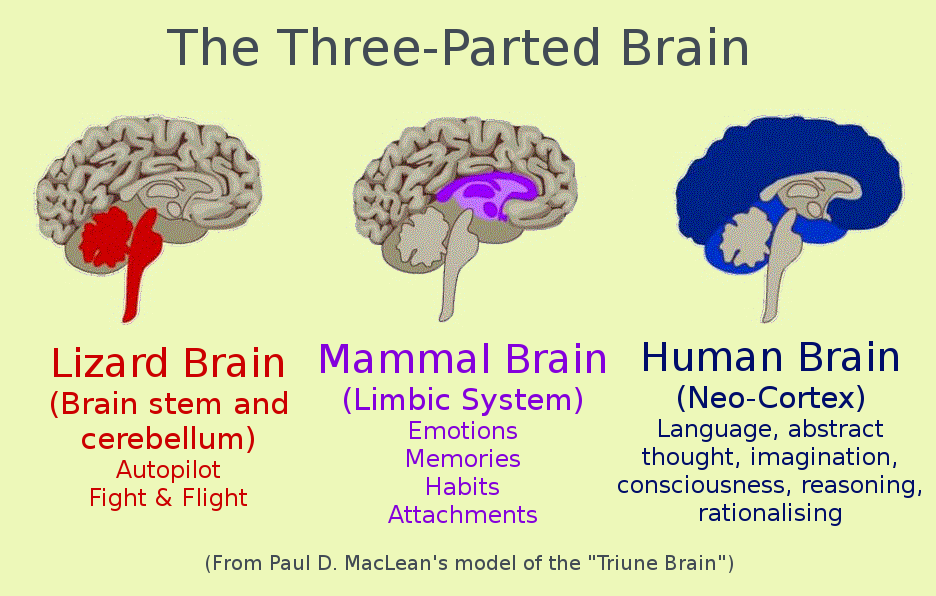
Who was Paul Maclean?
Paul D. MacLean (1913-2007) was an American physician and neuroscientist who made significant contributions to the study of brain evolution and behavior. He is best known for his triune brain theory, which proposed that the human brain is composed of three distinct evolutionary layers, each associated with different functions and behavioral patterns. MacLean’s work has had a profound influence on fields ranging from neuroscience to psychiatry to depth psychology, offering a compelling framework for understanding the complex and often conflicting aspects of human nature.
The Triune Brain Theory
MacLean’s triune brain theory, first introduced in the 1960s, posits that the human brain is a composite of three evolutionarily distinct structures: the reptilian complex (R-complex), the paleomammalian complex (limbic system), and the neomammalian complex (neocortex). Each of these structures emerged at a different stage of evolutionary history and is associated with specific behavioral and cognitive functions.
The Reptilian Complex (R-Complex)
The oldest and most primitive layer of the triune brain is the reptilian complex, which includes the brainstem and cerebellum. This structure is shared by all vertebrates and is associated with basic survival functions such as breathing, heart rate regulation, and instinctive behaviors. MacLean argued that the R-complex is the seat of ritualistic and territorial behaviors, as well as the source of our innate fight-or-flight response.
The Paleomammalian Complex (Limbic System)
The second layer of the triune brain is the paleomammalian complex, also known as the limbic system. This structure emerged with the evolution of early mammals and is associated with emotional processing, memory formation, and social bonding. Key components of the limbic system include the hippocampus, amygdala, and hypothalamus. MacLean suggested that the limbic system mediates our capacity for nurturing, playfulness, and emotional attachment.
The Neomammalian Complex (Neocortex)
The most recent and advanced layer of the triune brain is the neomammalian complex, represented by the neocortex. This structure is most developed in primates and is associated with higher cognitive functions such as language, abstract thought, planning, and self-awareness. MacLean proposed that the neocortex enables our capacity for symbolic reasoning, delayed gratification, and moral judgment.
Interaction and Conflict Among Brain Layers
A key aspect of MacLean’s theory is the idea that these three brain layers, while functionally distinct, are deeply interconnected and often work in concert to shape behavior and experience. At the same time, MacLean argued that conflicts can arise between the primitive impulses of the R-complex, the emotional demands of the limbic system, and the rational control of the neocortex. He suggested that many psychological and behavioral problems stem from a lack of integration or communication among these evolutionary layers.
Implications and Applications
Depth Psychology and Psychotherapy
MacLean’s triune brain theory has significant implications for depth psychology and psychotherapy. It offers a neurobiological grounding for many key concepts in psychodynamic and Jungian thought, such as the notion of the unconscious, the role of instinct and archetype, and the process of individuation.
The R-complex can be seen as a biological basis for what Freud called the “id” – the primitive, instinctual part of the psyche that operates according to the pleasure principle. The limbic system, with its role in emotional processing and memory, resonates with Jungian concepts such as the feeling-toned complexes and the personal unconscious. And the neocortex, with its capacity for self-reflection and abstract thought, aligns with the Jungian notion of the ego and the development of consciousness.
MacLean’s emphasis on the potential for conflict among brain layers also parallels depth psychological ideas about psychic tension and the need for integration of conscious and unconscious elements. His theory suggests that effective psychotherapy must address all levels of the brain, fostering communication and coherence among instinctual, emotional, and rational processes.
Evolutionary Psychology and Behavioral Ecology
The triune brain theory has also been influential in the fields of evolutionary psychology and behavioral ecology. It provides a framework for understanding how different behavioral patterns and cognitive capacities may have emerged in response to specific evolutionary pressures.
For example, the territorial and ritualistic behaviors associated with the R-complex can be seen as adaptations for resource competition and mate selection in ancestral environments. The emotional bonding and nurturing capacities of the limbic system may have evolved to support cooperative child-rearing and social cohesion in early human groups. And the higher cognitive functions of the neocortex can be understood as adaptations for navigating the complex social and ecological challenges of later human evolution.
MacLean’s work thus offers a way of bridging proximate and ultimate levels of explanation in the study of human behavior – linking the immediate neural mechanisms of cognition and affect with the evolutionary histories and adaptive functions of those mechanisms.
Neuroscience and Psychiatry
In the fields of neuroscience and psychiatry, MacLean’s triune brain theory has provided a influential model for understanding the functional organization of the brain and its relation to mental health and disorder. While the specifics of the theory have been debated and refined in light of subsequent research, the core idea of the brain as a layered, evolutionary structure remains a key heuristic.
MacLean’s work has inspired research on the neural bases of emotion, motivation, and social behavior, and has informed the development of therapeutic interventions that target specific brain systems. For example, approaches such as cognitive-behavioral therapy can be seen as working primarily at the neocortical level, while techniques like EMDR (eye movement desensitization and reprocessing) may engage limbic and even reptilian circuits.
The triune brain model also offers a framework for conceptualizing various psychiatric conditions. Disorders such as anxiety, PTSD, and addiction can be understood as involving dysregulation or hyperactivity in limbic and R-complex structures, while conditions like schizophrenia and autism may reflect disruptions in neocortical functioning and integration.
Embodied and Affective Neuroscience
MacLean’s emphasis on the evolutionary layering of the brain and the central role of subcortical structures in shaping behavior anticipated later developments in embodied and affective neuroscience. His work challenged the primacy of the neocortex and the traditional view of cognition as abstract and disembodied, instead highlighting the foundational role of bodily and emotional processes.
The triune brain theory aligns with contemporary views of the brain as a complex, hierarchical system in which lower-level structures constrain and inform higher-level processes. It is consistent with research showing the pervasive influence of brainstem, limbic, and endocrine systems on cognitive and behavioral outcomes, and the deep intertwining of reason and emotion in human experience.
MacLean’s model also resonates with embodied and enactive approaches to cognition, which emphasize the role of bodily states, sensorimotor coupling, and organism-environment interactions in shaping mental processes. The triune brain can be seen as a kind of “layered” embodiment, with each evolutionary level representing a distinct mode of engaging with the world.
Criticisms and Limitations
Despite its enduring influence, MacLean’s triune brain theory has been critiqued on various grounds. Some have argued that the model oversimplifies the complex evolutionary history of the brain and the intricate interconnections among its structures. The strict functional divisions among the three layers have been questioned, with evidence suggesting more distributed and overlapping roles.
Others have pointed out that the triune model can lead to a kind of “neural essentialism” or reductionism, if the complexities of human behavior and experience are too neatly mapped onto specific brain regions. There is a risk of falling into a simplistic “reptile brain” vs. “mammal brain” dichotomy that fails to capture the nuances of how these systems interact.
More broadly, some critics have challenged the explanatory power of evolutionary theories of brain and behavior, arguing that they can lapse into “just-so stories” or post-hoc rationalizations. The triune brain theory, like other evolutionary models, must be continually tested against empirical evidence and revised in light of new findings.
Finally, it’s important to recognize that MacLean’s work, while groundbreaking, was a product of its time and intellectual context. Subsequent research has elaborated on and modified many of his original ideas, and new frameworks have emerged for understanding the evolution and function of the brain. The triune model is best seen as a starting point for ongoing inquiry rather than a final or complete account.
Legacy and Implications
Paul MacLean’s triune brain theory represents a seminal contribution to our understanding of the evolutionary architecture of the human mind. By proposing that the brain is composed of three distinct but interconnected layers, each reflecting a different stage of evolutionary history, MacLean provided a compelling framework for integrating insights from neuroscience, ethology, and depth psychology.
The triune model has had a profound influence across multiple fields, from psychiatry and psychotherapy to evolutionary psychology and affective neuroscience. It has offered a way of grounding psychological concepts in biology, illuminating the deep roots of human behavior, and conceptualizing mental health and disorder.
At the same time, MacLean’s work has not been without its critics, and ongoing debates in neuroscience and evolutionary theory have challenged and refined many of his original ideas. As our understanding of the brain continues to evolve, the triune model is best seen as a generative starting point rather than a final destination.
Looking forward, MacLean’s legacy lies in his integrative vision of the brain as a product of evolution, shaped by the complex interplay of biology, environment, and experience. By highlighting the layered nature of the human psyche and the often-conflicting demands of our “three brains,” he opened up new avenues for research, therapy, and interdisciplinary dialogue.
As we grapple with the challenges of the 21st century – from mental health crises to social and political polarization to the existential threats of climate change and technological disruption – MacLean’s work reminds us of the deep evolutionary histories that shape our present and the need for a holistic understanding of the human condition. By embracing the triune nature of our being and working towards greater integration and coherence among our diverse neural and psychological capacities, we may yet chart a wiser course forward.
Bibliography
Cory, G. A., & Gardner, R. (Eds.). (2002). The evolutionary neuroethology of Paul MacLean: Convergences and frontiers. Praeger Publishers/Greenwood Publishing Group.
Gould, S. J. (1977). Ever since Darwin: Reflections in natural history. New York: Norton.
Holden, C. (1979). Paul MacLean and the triune brain. Science, 204(4397), 1066-1068.
Lambert, K. G. (2003). The life and career of Paul MacLean: A journey toward neurobiological and social harmony. Physiology & Behavior, 79(3), 343-349.
LeDoux, J. E. (1996). The emotional brain: The mysterious underpinnings of emotional life. New York: Simon & Schuster.
MacLean, P. D. (1985). Brain evolution relating to family, play, and the separation call. Archives of General Psychiatry, 42(4), 405-417.
MacLean, P. D. (1990). The triune brain in evolution: Role in paleocerebral functions. New York: Plenum Press.
Panksepp, J., & Biven, L. (2012). The archaeology of mind: Neuroevolutionary origins of human emotions. New York: W. W. Norton & Company.
Ploog, D. W. (2003). The place of the Triune Brain in psychiatry. Physiology & Behavior, 79(3), 487-493.
Porges, S. W. (2011). The polyvagal theory: Neurophysiological foundations of emotions, attachment, communication, and self-regulation. New York: W. W. Norton & Company.
Sagan, C. (1977). The dragons of Eden: Speculations on the evolution of human intelligence. New York: Random House.


























0 Comments